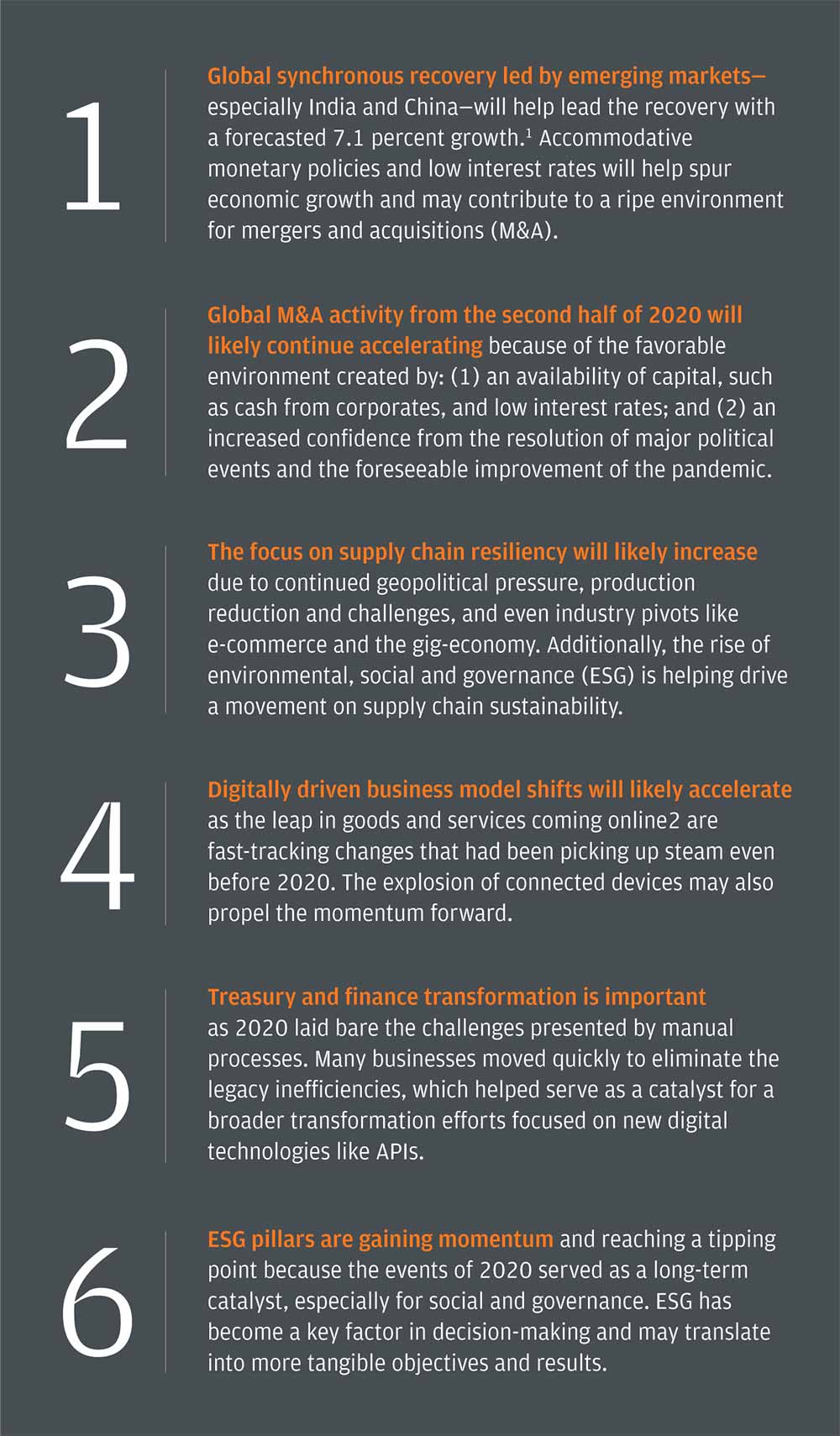Six trends shaping the landscape

Five priorities for Treasury and Payments to navigate the new environment
Amidst uncertainty and crisis, the role of treasury and payment teams in supporting business objectives has been amplified. Across our client engagements, we’ve helped teams take advantage of the positive trends and mitigate the negative ones. Here are the top five priorities every corporate treasury department should consider.

More than 60 percent of our clients globally cited business model pivots as the driver for their priorities.3 As they become must-haves for businesses to drive immediate and long-term growth, corporate treasury and payment teams need to join the journey and have a seat at the table.
Existing business models are predicted to gain more ground:
- Recurring revenue models are expanding beyond the typical industries and into B2B.
- Platform and ecosystem models are common in APAC and will likely now rise in NAMR and LATAM.
- Direct-to-consumer (D2C) was a common “Band-Aid” solution, but many businesses look to make the pivot permanent.
With the explosion of e-commerce, two new models will likely rise in prominence:
- Contextual commerce is currently small but fast-growing, especially as consumers gain familiarity and use more of the various digital channels—such as social media, voice-enabled, IoT and so on.
- The sharing economy model will likely gain popularity in the emerging e-commerce economies to bring more goods and services online and, therefore, grow the e-commerce environment further.

With the continued disruption on supply chain, as the economy rebounds, it is critical to strengthen the resiliency of your supply chain. Doing so will likely help position your business to capture the opportunities as demand comes back. A few practical considerations for the short and long term:
- Digitize your supply chain to help shift supply chain and trade processes away from paper, including using tools such as online bank platforms or industry tools.
- Review solutions for supplier resiliency and ensure your treasury processes align to your objectives whether it’s prioritizing critical suppliers or ensuring alignment with your ESG goals.
- Work together with procurement to analyze the full impact of supply chain sourcing and financing shifts. For instance, what are the FX risks associated with geopolitical pressures?

With expected fluctuations in the economy and with supply chain disruption, having a good pulse on working capital and visibility to liquidity is important for resiliency.

About 50 percent of our global clients identify accelerating their digital transformation as a priority.3 This was expected given the holistic push for digital acceleration and because leaders across all levels of the organization—board, executives and treasury—are aligned on prioritizing digital transformation.
Many clients are focusing on eliminating manual legacy processes with automation, but also look to redesign the core business for fundamental, meaningful shifts. It’s crucial for treasury and payments to align with their peers’ digital transformation plans.

Start on your journey today
ESG pillars are increasingly being incorporated into targets and objectives within organizations, even though it is still relatively early stage for treasury and payments. The corporate treasury can help support their organization’s ESG agenda through a broad set of treasury activities like payments strategy and execution, capital planning and allocation, working capital management, insurance purchasing, counterparty risk analysis, long-term investments, and long-term borrowing.
Other areas for corporate treasury to get involved include: (1) Making ESG-friendly investments (e.g. sustainability, green funds), (2) deploying ESG principles into supply chain management, (3) using sustainable financing and (4) incorporating ESG as an evaluating factor for counterparties.
As you and your teams dig deeper into your priorities, you may face a multitude of solutions, partnerships and strategies.
About the Authors:
Alison Livesey, Global Market Management
Varoon Mandhana and Sim Ung, APAC Solutions
Yousif Mohammed, EMEA Market Management
Lucia Li, NAMR Market Management
Dennis Paula, LATAM Solutions
J.P. Morgan, JPMorgan, JPMorgan Chase and Chase are marketing names for certain businesses of JPMorgan Chase & Co. and its subsidiaries worldwide (collectively, “JPMC”). The views and opinions expressed herein are those of the author and do not necessarily reflect the views of J.P. Morgan, its affiliates, or its employees. Neither the author nor J.P. Morgan makes any representations or warranties as to the information’s accuracy or completeness. The information contained herein has been provided solely for informational purposes and does not constitute an offer, solicitation, advice or recommendation, to make any investment decisions or purchase any financial instruments, and may not be construed as such.
Investments or strategies discussed herein may not be suitable for all investors. Neither JPMC nor any of its directors, officers, employees or agents shall incur in any responsibility or liability whatsoever to any party with respect to the contents of any matters referred herein, or discussed as a result of, this material. This material is not intended to provide, and should not be relied on for, accounting, legal or tax advice or investment recommendations. Please consult your own tax, legal, accounting or investment advisor concerning such matters.
Not all products and services are available in all geographic areas. Eligibility for particular products and services is subject to final determination by JPMC and or its affiliates/subsidiaries. This material does not constitute a commitment by any JPMC entity to extend or arrange credit or to provide any other products or services and JPMC reserves the right to withdraw at anytime. All services are subject to applicable laws, regulations, and applicable approvals and notifications. You should examine the specific restrictions and limitations under the laws of your own jurisdiction that may be applicable to you due to its nature or to the products and services referred herein.
Notwithstanding anything to the contrary, the statements in this material are not intended to be legally binding. Any products, services, terms or other matters described herein (other than in respect of confidentiality) are subject to the term of separate legally binding documentation and/or are subject to change without notice.
JPMorgan Chase Bank, N.A. Member FDIC.
JPMorgan Chase Bank, N.A., organized under the laws of U.S.A. with limited liability.







